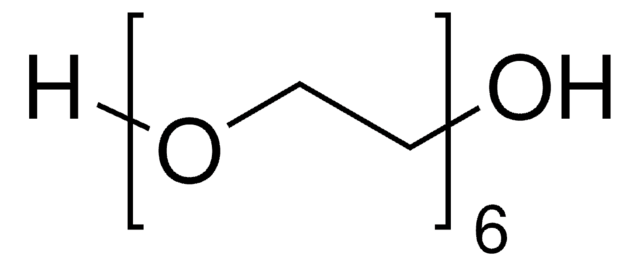689440
O-(2-Azido-ethyl)-heptaethylenglykol
≥95% (oligomer purity)
Synonym(e):
Azido-PEG (n=7)
About This Item
Empfohlene Produkte
Qualitätsniveau
Assay
≥95% (oligomer purity)
Form
powder
Mol-Gew.
average Mn 400
Eignung der Reaktion
reaction type: click chemistry
reagent type: cross-linking reagent
Ω-Ende
hydroxyl
α-Ende
azide
Funktionelle Gruppe
azide
hydroxyl
Lagertemp.
2-8°C
SMILES String
OCCOCCOCCOCCOCCOCCOCCOCCN=[N+]=[N-]
InChI
1S/C16H33N3O8/c17-19-18-1-3-21-5-7-23-9-11-25-13-15-27-16-14-26-12-10-24-8-6-22-4-2-20/h20H,1-16H2
InChIKey
BUMODEBRFGPXRM-UHFFFAOYSA-N
Anwendung
Some of the reported applications include:
- Synthesis of strain-stiffening hydrogels through self-assembly of oligomers fibres derived from Azido-PEG (n=7).
- Synthesis of biodegradable tetra-PEG hydrogels for drug delivery system.
- Synthesis of heterobifunctional oligo(ethylene glycol) linkers for bioconjugation and targeted drug delivery.
- Preparation of synthetic amphiphiles for programmed pH-dependent dispersions of carbon nanotubes (CNTs).
- Selective glycoprotein detection through allosteric click-imprinting by using a self-assembled monolayer developed from the above oligomer.
- Preparation of bioactivated quantum dot micelles containing fluorescent nanocrystals.
Verpackung
Signalwort
Warning
H-Sätze
Gefahreneinstufungen
Eye Irrit. 2 - Skin Irrit. 2 - STOT SE 3
Zielorgane
Respiratory system
Lagerklassenschlüssel
10 - Combustible liquids
WGK
WGK 3
Flammpunkt (°F)
Not applicable
Flammpunkt (°C)
Not applicable
Persönliche Schutzausrüstung
dust mask type N95 (US), Eyeshields, Gloves
Hier finden Sie alle aktuellen Versionen:
Besitzen Sie dieses Produkt bereits?
In der Dokumentenbibliothek finden Sie die Dokumentation zu den Produkten, die Sie kürzlich erworben haben.
Kunden haben sich ebenfalls angesehen
Artikel
Progress in biotechnology fields such as tissue engineering and drug delivery is accompanied by an increasing demand for diverse functional biomaterials. One class of biomaterials that has been the subject of intense research interest is hydrogels, because they closely mimic the natural environment of cells, both chemically and physically and therefore can be used as support to grow cells. This article specifically discusses poly(ethylene glycol) (PEG) hydrogels, which are good for biological applications because they do not generally elicit an immune response. PEGs offer a readily available, easy to modify polymer for widespread use in hydrogel fabrication, including 2D and 3D scaffold for tissue culture. The degradable linkages also enable a variety of applications for release of therapeutic agents.
Devising biomaterial scaffolds that are capable of recapitulating critical aspects of the complex extracellular nature of living tissues in a threedimensional (3D) fashion is a challenging requirement in the field of tissue engineering and regenerative medicine.
Unser Team von Wissenschaftlern verfügt über Erfahrung in allen Forschungsbereichen einschließlich Life Science, Materialwissenschaften, chemischer Synthese, Chromatographie, Analytik und vielen mehr..
Setzen Sie sich mit dem technischen Dienst in Verbindung.![2-[2-(2-Azido-ethoxy)-ethoxy]-ethanol -Lösung ~0.5 M in tert-butyl methyl ether](/deepweb/assets/sigmaaldrich/product/structures/374/007/eea7ca74-41e4-4aac-af71-c93c37ec0a5a/640/eea7ca74-41e4-4aac-af71-c93c37ec0a5a.png)











